Repeater widgets
Repeaters are used to display repeating patterns of widgets, such as rows of tabular data or layouts such as a product listing. When using a repeater widget, you can manage the content that displays in each instance of the repeated pattern directly from the repeater’s dataset table.
There are two examples of the repeater widget available in the Dynamic section of the Default widget library: a repeater table and a repeater card. Both repeater widgets have the same functionality.
You can also create a repeater from widgets that are already on the canvas by selecting and right-clicking them, and then selecting Create repeater in the context menu.
![]()
The item and the dataset
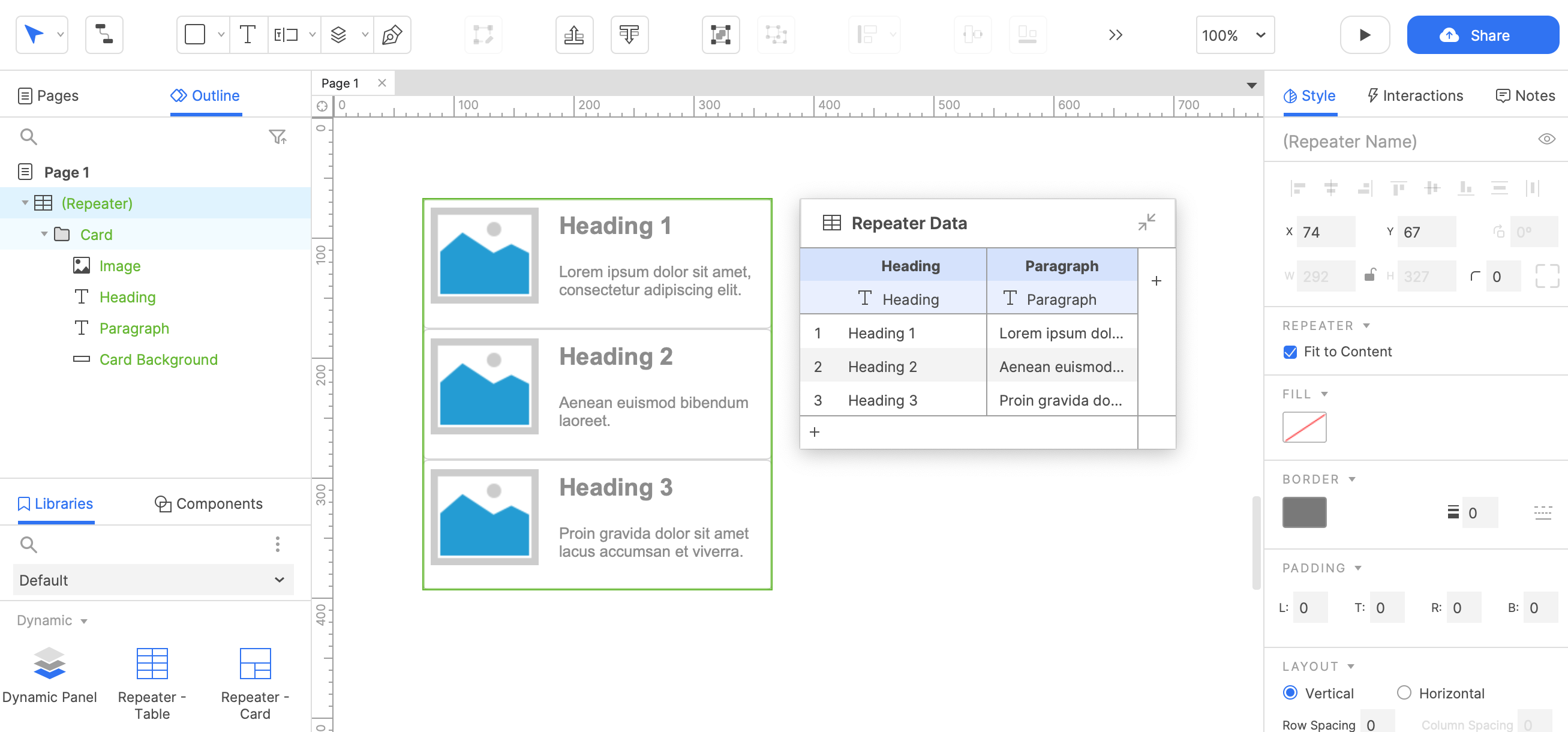
The repeater widget is made up of two parts: the "item", which contains the collection of widgets that will be repeated, and the "dataset", which contains the table of data that controls the content in each repetition.
Text and images stored in the dataset are displayed on widgets in the item when you select Connect widget under a column’s name in the dataset, and then choose from the list of available widgets in the dropdown.
The Item
The collection of widgets that is repeated is called the "item." You can edit the widgets in the item by double-clicking the repeater on the canvas or in the Outline pane.
While editing the item, you'll see only one instance of its contained widgets. The widgets in the repeater's item are repeated once for each row of the repeater's dataset table.

The dataset
The table of data that controls a repeater's item repetitions is called the "dataset." The floating dataset table will automatically appear when you click on a repeater, and you can expand the floating dataset by clicking and dragging the bottom-right corner. You can also collapse the dataset’s content by clicking on the collapse/expand icon in the top-right corner of the dataset table.
The data in a repeater's dataset are what determine the different content shown in each repetition of the repeater's item. For example, the repeater table widget in the Default library starts with three rows of data, each containing different sample content, which is what you see printed on the repeater's three repetitions on the canvas.
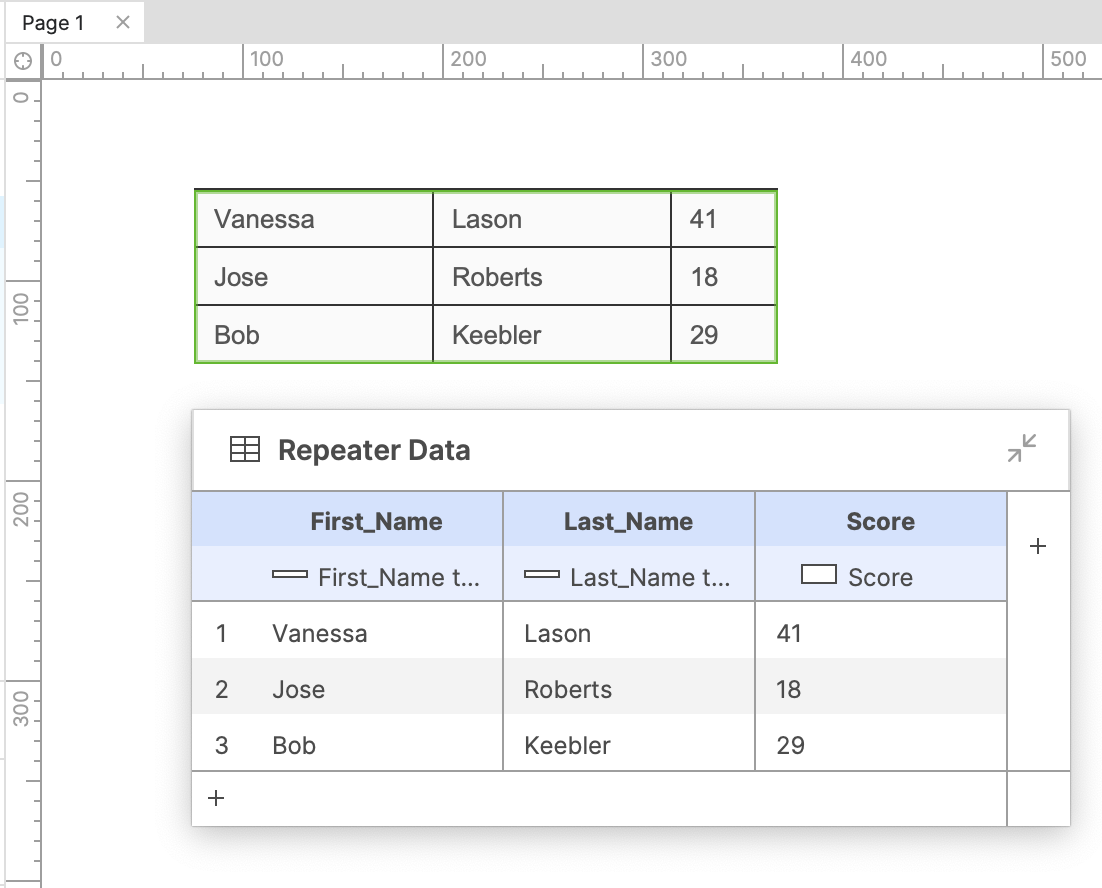
You can paste tabular data from spreadsheet applications like Microsoft Excel and Google Sheets into a repeater's dataset by selecting a cell and pressing CTRLV (Windows) or CMDV (Mac).
Displaying data in the item
Text and images
To enter text into a dataset cell, select the cell and start typing. Alternatively, you can double-click a cell to edit its existing text. dataset cells can also hold image files. Right-click a cell and select Import Image to bring up your computer's file browser, from which you can select your desired image.
To display text and images from each dataset column onto widget’s in the repeater's item, click Connect widget, and then choose a widget from the target dropdown.

Reference pages and urls
dataset cells can also hold URLs and references to other pages in the RP file. Enter URLs as plain text. To save a page reference, right-click a cell and select Reference page. In the dialog that appears, select the page you want to store a reference for.
You can use URLs and page references to create Open Link interactions on widget events in the repeater's item — for example, a button widget's Click or tap event. Select Link to external URL in the Link to dropdown, and then click the fx icon next to the text field with the https:// text.
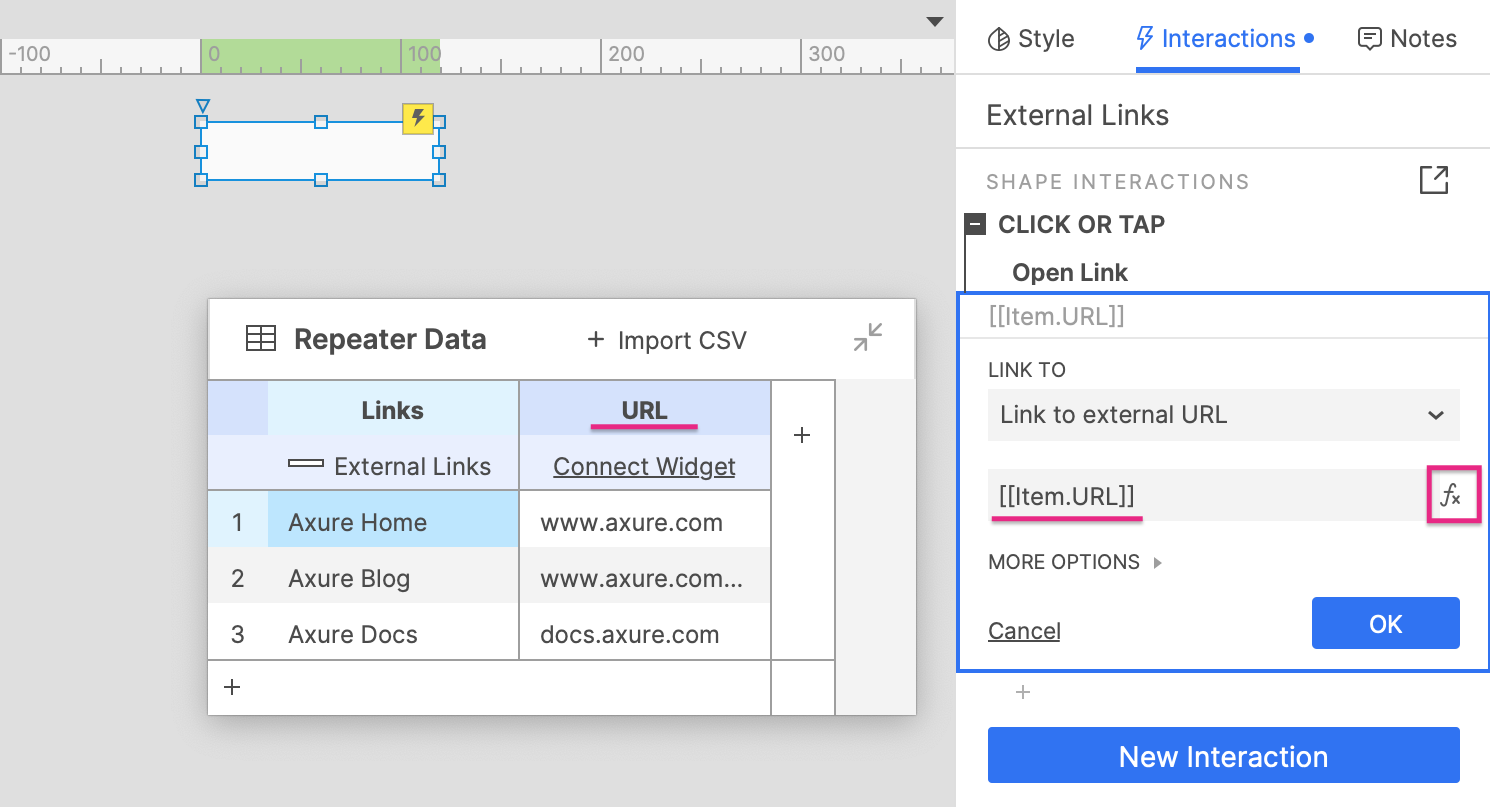
At the top of the Edit Value dialog that appears, click Insert Variable or Function. In the Repeater section of the dropdown, click Item.ColumnName, where "ColumnName" is the name of the dataset column containing the URLs and page references.
Click OK to close the Edit Value dialog. When you preview the prototype in the web browser, you should now be able to navigate to the URLs and prototype pages referenced in the repeater's dataset via the interaction you just created.
Importing data
You can import data from CSV files by selecting Import CSV on the top of the dataset table. When importing a CSV file, columns and rows will automatically be added to the dataset as needed.
Existing content in the dataset will be overwritten when importing a CSV file.
Special properties
Layout, spacing, and pagination
By default, all of a repeater's items are visible, and they're laid out vertically in a single column with no blank space between items. You can change this with the options in the Layout and Pagination sections of the Style pane.
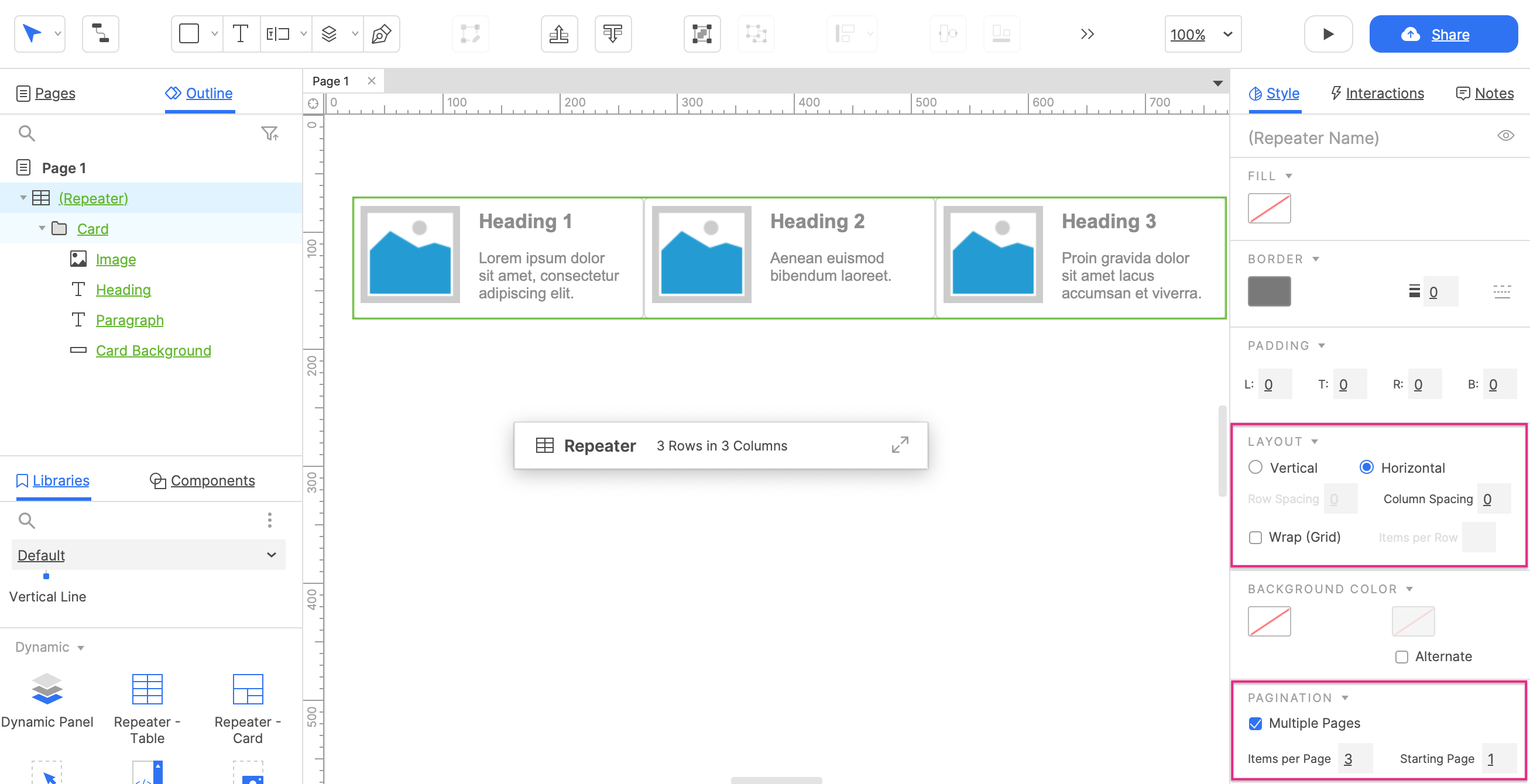
Layout
In the Layout section, you can choose whether the repeater's items should be stacked vertically in a column or horizontally in a row. If you would like your repeater to break into multiple columns or rows, check the Wrap (Grid) checkbox and enter the number of items you want each column or row to have.
Spacing
You can also specify how much empty space there should be between the rows and/or columns of repeater items in the Layout section of the Style pane as well. If you've set a background color for the repeater, it will be visible in this empty space.
Pagination
Paginating a repeater breaks its items up into multiple "pages" — not to be confused with the prototype pages in the Pages pane — so that you can control how many items are visible at a time.
In the Pagination section of the Style pane, check the box for Multiple pages. Enter the number of items you want to appear on each page, and enter the number of the page you want the repeater to start on (defaults to 1). You can navigate the repeater's pages using the Set Current Page action, and you can dynamically change the number of items per page using the Set items per page action.
To learn more, take a look at the Repeater Pagination tutorial.
Borders, backgrounds, and padding
You can add borders and a background color to repeaters using the Fill, Border, and Corner radius options in the Style pane. Repeater borders and backgrounds render behind the widgets in the repeater's items, so you may need to add padding to the repeater in order to see them. The options in the Padding section of the Style pane allow you to create blank space between the repeater's outer edges and its items.
Repeater items can also have their own background color that's different from the background of the repeater itself. You can select this color in the Background color section of the Style pane. Additionally, you can check the box for Alternate to select a second color that will be applied to every other item. This option is handy when building tables with the repeater widget.
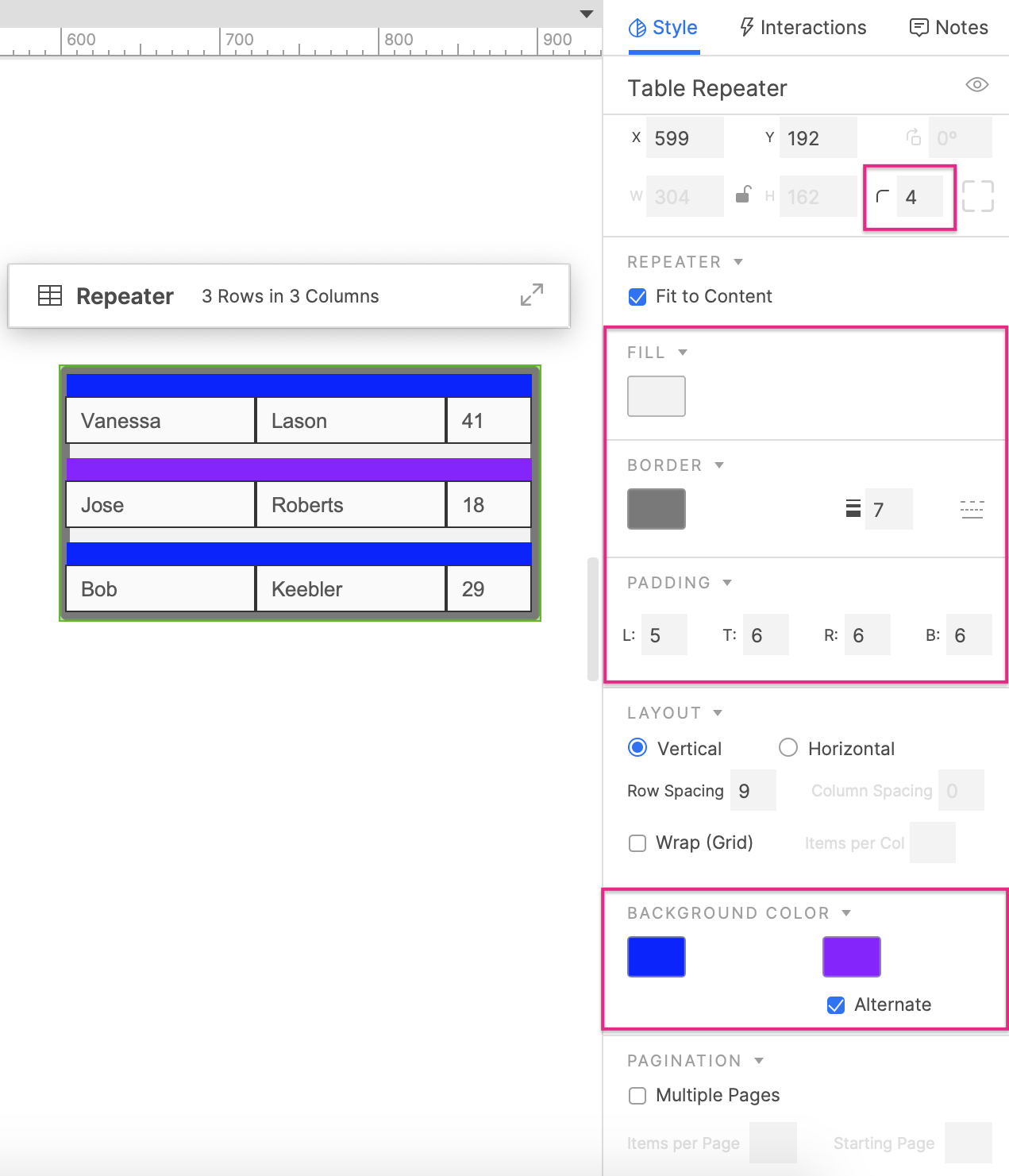
Fit to content in HTML
The Fit to content in HTML checkbox is located just above the dataset in the Style pane and is enabled by default. With this option enabled, each repeater item will automatically resize to fit to its contained widgets.
If you disable this option, each repeater item will remain at a fixed size, regardless of any changes to the size, position, or visibility of its contained widgets. Widgets moved or shown dynamically might overlap other repeater items if they extend outside the fixed boundaries of their own item.
Isolate radio groups and selection groups
By default, radio groups and selection groups in the repeater item are evaluated separately for each instance of the item. For example, if the item has a radio group with three radio buttons in it, selecting one of the buttons will unselect the other two buttons in that instance of the item, but the other radio buttons in the other instances of the item will not be affected.
You can change this behavior by unchecking the boxes for Isolate Radio Groups and Isolate Selection Groups, located in the lower section of the Interactions pane. When these options are toggled off, radio groups and selection groups in the repeater item are evaluated across every instance of the item. Going back to our previous example, this would mean that selecting a radio button in the radio group in one instance of the item would unselect all other buttons in that radio group in every other instance of the item.
The repeater mask
Repeaters have a green border mask by default to make their contained widgets easier to differentiate from others on the canvas. You can toggle the mask at View → Masks in the application menu.
Widget masks, including the repeater mask, are not applied in the web browser.
Special interactions
Repeater-specific events
Item loaded
As an alternative to using the Connect widget option, you can display content on repeaters with the Item loaded event. This approach is more advanced, but is called for in certain situations, such as when using math functions or expressions to dynamically generate text or numeric values.
The Item loaded event fires once for each instance of the repeater item that gets loaded in the web browser. For example, the event would fire three times for a repeater whose dataset contains three rows since each row creates a new instance of the item. Furthermore, the Item loaded event always handles dataset rows in order from top to bottom.
A repeater loads all its items when the page first loads, and it reloads all its items whenever changes are made to the repeater's dataset. This means that the item loaded event fires once for every instance of the item at page load and every time dataset rows are added, deleted, or updated.
Item resized
The Item resized event fires whenever an instance of the repeater item is resized due to changes to its contained widgets. This only happens when the repeater is set to Fit to Content.
Sorting and filtering rows
Sorting
Using the Add sort and Remove sort actions, you can dynamically sort a repeater's rows by any of its dataset columns. You can sort the column's values as any of the following data types:
- Number
- Text
- Text (Case Sensitive)
- Date – YYYY-MM-DD
- Date – MM/DD/YYYY
You can also choose to sort the rows in ascending or descending order, or you can toggle between the two whenever the sort is reapplied.
To learn more, check out the Sorting repeater rows tutorial.
Filtering
Using the Add filter and Remove filter actions, you can dynamically filter a repeater to only display rows that meet certain criteria. You define these criteria with boolean expressions that compare one value, usually a dataset column or other repeater item property, to another. Some simple examples include the following:
-
[[Item.State == 'CA']]would display only rows with the value "CA" in the State column -
[[Item.Price <= 20]]would display only rows whose value in the Price column is less than or equal to 20 -
[[Item.TasksCompleted != Item.TasksAssigned]]would only display rows whose value in the TasksCompleted column does not equal their value in the TasksAssigned column
To learn more, check out the Filtering Repeater Rows tutorial.
Editing the dataset Dynamically
You can dynamically change a repeater's dataset in the web browser using the following actions:
- Add rows lets you add new rows to the dataset
- Delete rows deletes rows from the dataset
- Edit row data lets you change the column values for existing rows in the dataset
- Mark rows lets you designate rows to be deleted or updated at a later time
- Unmark rows unmarks previously marked rows
You can learn more about working with these actions in the Adding, deleting, and updating repeater rows tutorial.
Dataset objects and properties
In addition to the contents of each row in the repeater's dataset, you can also access meta information about the dataset in value expressions by using the objects and properties below.
Item and TargetItem
The Item object refers to the individual repeater dataset row being handled by a given interaction, usually an action under the Item loaded event. (This is the object you've seen used to access column values in previous sections of this document.)
TargetItem is a similar object that gives you access to all the same properties as Item. The difference between the two is that you can use TargetItem in an interaction on a widget inside the repeater's item to access information about other items in the repeater.
You can use the following properties with the Item and TargetItem objects:
-
Item.ColumnName: Represents the data stored in the named column. (This is the property you've seen used in previous sections of this document.)
-
Item.isFirst: Returns
trueif the row is the first visible row in the repeater, after all sorting, filtering, and pagination have been applied. Otherwise, it returnsfalse. -
Item.isLast: Returns
trueif the row is the last visible row in the repeater, after all sorting, filtering, and pagination has been applied. Otherwise, it returnsfalse. -
Item.index: Numeric value that represents the row number in the dataset. For example, this value for the third row in the dataset would be
3. -
Item.isEven: Returns
trueif Item.index is an even number. Otherwise, it returnsfalse. -
Item.isOdd: Returns
trueif Item.index is an odd number. Otherwise, it returnsfalse. -
Item.isMarked: Returns
trueif the row is currently marked. Otherwise, it returnsfalse. -
Item.isVisible: Returns
trueif the row is currently visible in the repeater, after all filtering and pagination have been applied. Otherwise, it returnsfalse.
Repeater
The Repeater object provides information about a repeater's entire dataset. When working with a widget event inside the repeater's item, you'll access this object with Item.Repeater: [[Item.Repeater.dataCount]]
You can also use that notation when working with the repeater's own events, or you can use This as a shortcut since the repeater is accessing its own properties: [[This.dataCount]]
When working with a widget or page event that exists outside the repeater, you'll need to store the repeater as a local variable and then append the properties below to the local variable name: [[LVAR1.dataCount]]
You can use the following properties with the Repeater object:
-
Repeater.dataCount: Numeric value that represents the total number of rows in the repeater's dataset.
-
Repeater.itemCount: Numeric value that represents the number of rows in the repeater after all filtering has been applied.
-
Repeater.visibleItemCount: Numeric value that represents the current number of visible rows in the repeater, after all filtering and pagination has been applied.
-
Repeater.pageCount: Numeric value that represents the total number of pages in the repeater.
-
Repeater.pageIndex: Numeric value that represents the number of the currently visible page in the repeater.